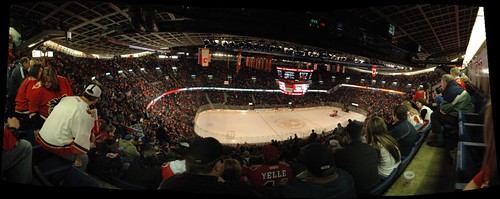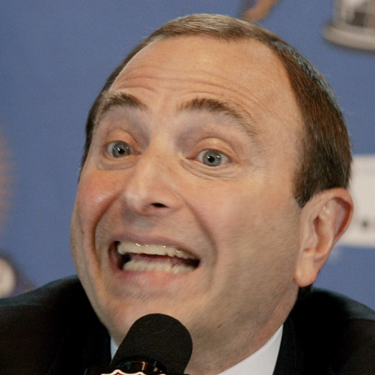Welcome to the fourth edition of my little series here at Puck Money called Playing Below Capacity. Playing Below Capacity is where I take a look at teams that are playing in front of crowds of less than 85% at home (as of
December) to see what they are doing right and wrong to try to get people in the seats. The first edition was the
Devils, followed by the
Kings, and most recently topped by the
Predators (featured on Yahoo's Puck Daddy!). Today, its off to the desert of Glendale, Arizona; where the Coyotes are obviously in a boatload of financial concerns as of late. I will do my best to steer clear of those and focus on the attendance issues at hand.
Phoenix is 25th in attendance ranked by capacity, with a rating of 84.6% through 24 home games. Let's begin.*
*
Warning: Please remember that I'm a young college kid who thinks he knows what he's talking about. Any "problems" that I suggest the Coyotes have are my opinion and are most likely not that accurate. Also, any information I used can easily be found on the Internet as I am a typical lazy college kid. With that said, enjoy.Here are the ideas I came up with that could be problems with getting people to go to
Coyotes game on a regular basis...
- Arena Location/Age
- High Ticket Prices/Poor Promotional Events
- Metro Population
- On Ice Product
- Location/History of Franchise
- Other
Before we get going, some facts of the Phoenix Coyotes (
wikipedia):
- The "Coytoes" moved to Phoenix in 1996 after being known as the Winnipeg Jets since 1972. The Jets were apart of the WHA from '72-'79 and then merged into the NHL.
- The Coyotes have made the playoffs five times in their 11 seasons in the desert. All five playoff appearances came in their first six seasons, their last in 2001-2002.
- They originally played a the US Airways Center in Phoenix for seven years until 2003. The team then moved to Glendale to the new Jobing.com Arena.
- The Capacity for Ice Hockey at Jobing.com Arena is 17,799.
And so we move on...
- Arena Location/AgeWith
Jobing.com being only six years old this season, I'm sure the quality of the arena
isn't keeping fans away in the desert.
What has been debated though is the location of the Arena, in neighboring Glendale, about 20-30 minutes away from Phoenix. Here is a screenshot via Google Maps (click to enlarge):
 Jobing
Jobing.com Arena is noted by the arrow labeled "B" in the picture. I asked Google for directions from Phoenix to the Arena and the blue line is what popped up, a 23 minute ride by car.
The Arena is on the outskirts of town, but Phoenix is surrounded by
residential areas full of possible '
Yotes fans. Take another look at the picture. Downtown Phoenix isn't anything to imposing. Phoenix is basically set up like a giant retirement community. The roads are straight and the blocks are perfectly square, and like I said,
residential areas all around. One thing I think that could make a difference is not playing in downtown Phoenix at the US Airways Arena, where the Suns of the NBA play and have
always had better attendance.
To an outsider, it may seem like an issue. Some Coyotes fans in the link I provided above about the Coyotes home being debated about seem to think its really a non-issue. Take a look at this
picture now (click to enlarge):

Many fans point out that the
Jobing.com Arena sits right next door to the University of Phoenix Stadium; where the
Cardinals have sold out every game and many college basketball games do well. This is a fair
argument, but I still think that if the Coyotes were playing in downtown Phoenix, they might get a slight attendance boost.
I also wanted to mention the parking aspect at Jobing.com Arena. According to thesportsroadtrip.com,
parking at the Arena is free, the only team in the major four to do so. There have been rumors that the Coyotes might start charging for the space, but none that I can link to.
- High Ticket Prices/Poor Promotional EventsThe Coyotes made famous the "All you can eat" tickets, in an effort to draw a nice crowd on New Years Eve, 2008. It worked, somewhat. They saw their second highest crowd since opening night, with 16,199 packing into
Jobing.com Arena to watch some hockey and eat their hearts out. As for ticket prices, the Coyotes don't (and really can't afford to) kill you. In 2008-2009, the
Coyotes rank 28th in the Fan Cost Index at Teammarketing.com. The Fan Costs Index:
comprises the prices of four (4) average-price tickets, two (2) small draft beers, four (4) small soft drinks, four (4) regular-size hot dogs, parking for one (1) car, two (2) game programs and two (2) least-expensive, adult-size adjustable caps.
This years
FCI for Phoenix is only one of four teams to decrease from last season. Their
FCI is at $221.80, which is about $65 below the NHL Average. Their average ticket comes in at $37.45, about $12 below the NHL Average. Finally, which was a shock to me, their average premium ticket price is $129.23, about $15 above the NHL Average. Along with the low ticket prices, the Coyotes
do some nice giveaways (mostly in the first half of the season), plus some
great discounted prices (Only $20 for a lower-level ticket for students and
military, wow).
Do I really think the ticket prices and offers are keeping fans away? No. The fact of the matter is, anyone that really wants to go to a sports event, especially hockey fans, will find the money to do so. But hey, at least the Coyotes
haven't been accused of
buying their own tickets like the Predators, yet.
- Metro PopulationThe cities of Glendale and Phoenix combine to have a population around 1.7 million people, with
almost 50% of the population in Phoenix being non-
Hispanic white, the
NHLs main demographic. Glendale is ranked 28
th by
Statshockey.net in city population size in the NHL, but the Phoenix Metro Area comes in with just over 4 million people.
4 Million ranks Phoenix about average in the NHL in terms of Metro population. And as I showed you with the demographics clip,
there is plenty of possible hockey fans. So the people are there,
that's fore sure.
- On Ice ProductEveryone loves a winner. Take a look at this chart and graph below (click to enlarge):

As you can see, the real Attendance boost came in '03-'04, when the team had post two consecutive solid seasons and got their
reputations up. Now that the Coyotes have an achieving young core poised to make the playoffs for the first time since 2002, the '
Yotes may really help their bottom line come this spring.
I think the On-Ice product is an issue. It is not THE issue for the Coyotes, but it
definitely doesn't hurt to have a winner in what I like to call a "
Bettman" market. I'll touch on that more later. If the Coyotes stick around in Phoenix, the crowds will be dazzled by
Turris, Mueller, and
Tikhonov for years to come. Throw in some solid
goaltending by
Ilya Bryzgalov and some pest-work by Daniel
Carcillo and you being to see why the Coyotes are currently sitting in 5
th place.
The Coyotes need to finish this season off strong on the ice to take some pressure surrounding the team and its ownership off the ice.
- Location/History of FranchiseIt's the (favorite fun word here) desert. The Coyotes are in Phoenix because back in the late 90's player salaries got out of control and the small but constantly sold-out
MTS Centre in Winnipeg couldn't support the Jets. Now, the fifth largest city in the United States, with a perfectly good arena and hockey club (this season at least), cannot support the Coyotes. Hockey is really only
prevalent in Arizona because of the Coyotes and because of any retired folk there. I'm sure the Coyotes have grown the game a bit, but from my experience with USA Hockey (reading the monthly magazines, playing), you don't hear a lot about quality youth hockey being played in Arizona. What I will give the state is that they have the same amount of rinks of
Tennessee and Georgia, combined (click to enlarge):

Off-note: 920 rinks in
Ontario. Enough said.
- OtherI added this Other section because I have to share these photos when were talking about Attendance issues and the Coyotes. Plus I wanted to touch upon their meaning:


I took a look at who I think is
"telling the truth" when it comes to reporting attendances back in December. The Coyotes fell into my "liars" list, naturally. Above is the Coyotes November 1st tilt against the Minnesota Wild. The reported attendance was 14,817. Now I have mentioned before on this site that it is really the clubs decision whether to announce the true attendance or the paid
attendance. Some clubs, like the Coyotes, have to announce the paid; otherwise the team would be halfway to Ontario to play in one of its 920 rinks.
The above is truly a sad sight, but it is the results of a
Bettman market. Phoenix is a great big US city with lots of televisions. This, contrary to
Commissioner Bettmans hopes, doesn't
necessarily equal a successful hockey market. Buffalo and Minnesota are successful hockey markets because the game is loved and put above all else there, and teams should always be in those markets because of this.
The Coyotes will obviously be
receiving nice checks in the form of revenue sharing this season, no doubt about it. But when a team in the 5
th largest city of the US is
dead last in overall team value and has lost more money than one would care to know, along with being the only team in the league to actually lose value last season, why does
Bettman insist on keeping this franchise in the desert? I know a lot of this is easier said than done, but how he can keep ignoring the fact that some of his Southern Expansion markets are just not going to work in the long run is beyond me (Atlanta and Florida are also to me not going to work).
- ConclusionAttendance in Glendale and Phoenix has not been great since the turn of the century. But to be fair, neither really have the teams been either. To me, beyond the fact that the On-Ice product hasn't been great (with this season and '01-'02 being the exceptions) and the team moved 30 minutes outside of Phoenix, the bigger problem is clearly the market. And this isn't news, but more or less just a conformation. All the money news swirling around the club off the ice has surprisingly not affected the locker-room, which is promising. If the Coyotes continue down this path and cannot find a new owner, Mr.
Bettman may have to concede to the very thing he seems to hate, relocation.
One last thing.
Bettman seems to be content on selling the Coyotes to anyone who is willing to put up the cash (unless your name rhymes starts with a B and ends in
alsillie). I'm sure fellow NHL Owners cannot pleased about this, as this may not be the best business strategy.
So that about wraps up the fourth edition of my series here at Puck Money, Playing Below Capacity. Be sure to check back next week as we should have another fun, relocation rant filled edition as the New York Islanders are next up on the list. Please feel free to comment and let me know if I made any mistakes.
More to come later, by the way.





























